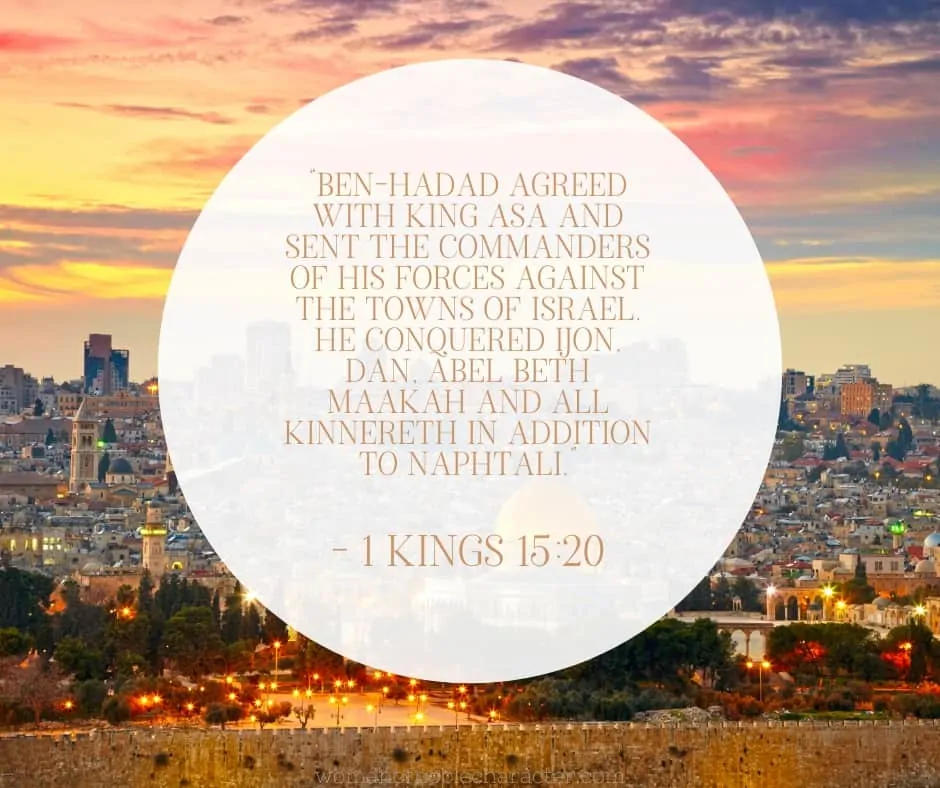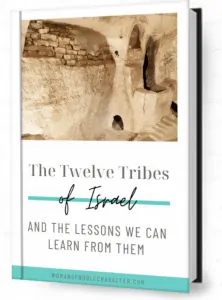The Tribe of Naphtali: Blessings, Territory, Invasions and Symbols
As we continue our series on the Twelve Tribes of Israel, we move to the Tribe of Naphtali. Naphtali is one of the twelve sons of Jacob.
When Naphtali was born, Rachel declared “I have had a great struggle with my sister, and I have won.” – Genesis 30:8
So she named him Naphtali.” Naphtali means “my struggle” or “my wrestling.” It may be written as Naphtali or Naphtali and in Hebrew as Naftali or נַפְתָּלִי

Post Contentshide1 Jacob and Moses Bless Naphtali2 The Territory of the Tribe of Naphtali2.1 The Tribe of Naphtali is Invaded2.2 Tribal Symbols of Napthali
Jacob and Moses Bless Naphtali
As he did for all of his sons, Jacob gave this blessing to Napthali:
“Naphtali is a doe set free
that bears beautiful fawns.* —Genesis 49:21

The last part has also been translated as “he utters beautiful words”.
You can find everything that you are looking for about the tribe of Israel on my website, but if you would like a study of all 12 Tribes of Israel, (plus the two half tribes) you can purchase the ebook for your convenience. No ads, no pop ups and you’ll have it forever to refer to when studying the sons of Jacob. It includes videos and additional downloads. The best part – it’s only $10 for over 230 pages!! Your choice, read it here or have it forever.
That means that the tribe of Naphtali will be blessed with outstanding Torah scholars. Moses also blessed the tribe in Deut. 33:23:
“About Naphtali he said:
Naphtali is abounding with the favor of the Lord
and is full of his blessing;
he will inherit southward to the lake.”. – Deuteronomy 33:23
The Song of Deborah is certainly among the most beautiful writings that the Tribe of Naphtali produced. The Song of Deborah is only second to the Song which Moses and the children of Israel sang after the miraculous crossing of the Red Sea. The Prophetess Deborah is the most famous daughter of the Tribe of Naphtali. Naphtali was also known as a messenger of good news. He was the first to reach Jacob to bring the good news that Joseph was still alive in Egypt, in addition to quickly running off to Egypt to bring the deed of land title for the Cave of Machpelah to show proof that Esau had sold his burial spot to Jacob. Esau did not want to allow it, claiming that the last free burial spot was his.
The Territory of the Tribe of Naphtali
The approximate location and boundaries of the 12 landed Israelite tribes, based on records in the Book of Joshua. This, and more, was The Promised Land given by God to the descendants of Israel, the grandson of Abraham. The full extent of the Canaanite land promised was never acquired, due to the repeated disobedience of the Israelites during the their commanded conquest of this very idolatrous, heathen land, after the Exodus from slavery in Egypt and the following 40 years of Divine punishment wandering in the wilderness, before Joshua and the living descendants were allowed to enter the land, following the death of Moses. The possession assigned to this tribe is set forth in Josh. 19:32-39.
“The sixth lot came out for Naphtali according to its clans:
Their boundary went from Heleph and the large tree in Zaanannim, passing Adami Nekeb and Jabneel to Lakkum and ending at the Jordan. The boundary ran west through Aznoth Tabor and came out at Hukkok. It touched Zebulun on the south, Asher on the west and the Jordan on the east. The fortified towns were Ziddim, Zer, Hammath, Rakkath, Kinnereth, Adamah, Ramah, Hazor, Kedesh, Edrei, En Hazor, Iron, Migdal El, Horem, Beth Anath and Beth Shemesh. There were nineteen towns and their villages.
These towns and their villages were the inheritance of the tribe of Naphtali, according to its clans.”
It lay in the northeastern corner of the land, bounded on the east by the Jordan and the lakes of Merom and Galilee, and on the north it extended far into Coele-syria, the valley between the two Lebanon ranges. It included a greater variety of rich and beautiful scenery and of soil and climate than fell to the lot of any other tribe. The territory of Naphtali extended to about 800 square miles, being double of that of Issachar. The region around Kedesh, one of its towns, was originally called Galil, a name afterwards given to the whole northern division of Canaan. A large number of foreigners settled here among the mountains, and therefore it was called “Galilee of the Gentiles”
“Land of Zebulun and land of Naphtali,
the Way of the Sea, beyond the Jordan,
Galilee of the Gentiles—
the people living in darkness
have seen a great light;
on those living in the land of the shadow of death
a light has dawned.” – Matthew 4:15-16.
The southern portion of Naphtali has been called the “Garden of Palestine.” It was of unparalled fertility. It was the principal scene of our Jesus’ public ministry. Here most of his parables were spoken and his miracles performed. At the time of the Exodus, The Tribe of Naphtali numbered 53,400 adult males (Numbers 1:43), but, at the close of the wanderings, they numbered only 45,400 (26:48-50). Along with Dan and Asher, they formed “the camp of Dan,” under a common standard (2:25-31), occupying a place during the march on the north side of the tabernacle.
The Tribe of Naphtali is Invaded
Naphtali was the first tribe to be invaded by Benhadad, king of Syria, in the reigns of Baasha, king of Israel, and Asa, king of Judah.
“Ben-Hadad agreed with King Asa and sent the commanders of his forces against the towns of Israel. He conquered Ijon, Dan, Abel Beth Maakah and all Kinnereth in addition to Naphtali.” – 1 Kings 15:20
(and in 2 Chronicles 16:4).

In the reign of Pekah, king of Israel, the Assyrians under Tiglath-pileser swept over the whole north of Israel, and carried the people into captivity. And, thus the kingdom of Israel came to an end . This occurred around B.C. 722.
“In the time of Pekah king of Israel, Tiglath-Pileser king of Assyria came and took Ijon, Abel Beth Maakah, Janoah, Kedesh and Hazor. He took Gilead and Galilee, including all the land of Naphtali, and deported the people to Assyria.” – 2 Kings 15:29
Later, Naphtali became almost entirely a desert. The town of Tiberias, on the shore of the Lake of Galilee, and Safed being the only places in it of any importance. The Midrash (an ancient commentary on part of the Hebrew scriptures, attached to the biblical text. The earliest Midrashim come from the 2nd century AD, although much of their content is older.) expands on the Sea of Galilee and its relationship to the tribe of Naphtali: The people of the tribe of Naphtali earned God’s blessings in the fullest measure because their conduct was in fullest compliance with God’s will. Their reward will be both in the World to Come (which is likened to the “sea”), as well as in this present world (likened to “land”). The sea is a vast area covered by water; we cannot see what’s going on in the sea. But on land we can see everything. Similarly, the World to Come is called the “Hidden World,” while the present world, the “here and now,” is called the “Revealed World.”
More importantly: When a person is about to make a sea voyage, he must provide himself with all the necessary needs for his long voyage, since on high seas there is nothing he can buy; only on land, before he sets out to sea, can he obtain all his necessities. Similarly, the Torah teaches us this world is where a person prepares for the Eternal World, the World To Come (Olam Habba), and the only things that count in the Eternal World are the eternal values a person acquires in this world. (overview from Jewish Encyclopedia)
Tribal Symbols of Napthali
- The traditional symbols for Naphtali include the deer, hind, gazelle or stag, and sometimes features a fruit basket.
- The Gemstone for Naphtali is an Amethyst (Akhlama), which is purple. For the flag banner it is a light red color.
- The tribe’s color is deep red or burgundy.
You may enjoy this sermon on the Tribe of Naphtali by Pastor Omar Thibeaux.
For deeper study on the Tribe of Naphtali, consider one of these recommended resources:
The Study of The Twelve Tribes of Israel
The Ten Lost Tribes: The History and Mystery of the Lost Tribes of Israel






